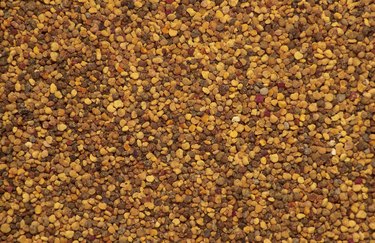
For the brave of heart, Chinese mustard makes an ideal hot dipping sauce for egg rolls, won tons, crab rangoon and other fried appetizers. It also adds a bit of bite to American fast-food staples like chicken nuggets and popcorn shrimp or when used in a pungent sauce for steak. While the Chinese mustard's spiciness might remind you of horseradish, the mustard owes its eye-watering properties solely to the mustard seeds used to create it.
Enzyme Effect
Video of the Day
Chinese mustard's primary ingredient is mustard seed. Its horseradish-like heat doesn't come from horseradish; instead, it's hot because the mustard seed used to create it is highest in myrosinase, an enzyme that causes heat when cracked and mixed with liquid. These brown seeds, from the Brassica juncea mustard plant, result in a mustard that is much more intense than the yellow seed most often used in American yellow "hot dog" mustard.
Video of the Day
Prepared vs. Powdered
When you think of Chinese mustard, you may remember the ground powder found in specialty markets. Mustard powder is made by grinding whole mustard seeds into a fine powder. In Chinese and some European mustard powders, the hotter brown seeds are used. Chinese mustard can also refer to prepared versions. These mustards, like Dijon or hot dog mustards, are the ready-to-use condiments with a paste-like consistency, often sold in jars. They're made by mixing mustard powder with a liquid.
Mustard Making
If you can find Chinese mustard powder in an ethnic market, use it to create your own authentic prepared Chinese mustard. Or you can use English mustard powder, which is about as hot and much more readily available. To make Chinese-style mustard, blend equal parts boiling water with English or Chinese mustard powder, stirring vigorously. Then incorporate a drizzle of sesame oil or white vinegar until the mustard reaches the consistency you prefer. Add such Asian spices as ground ginger or Szechuan pepper, if desired.
Horseradish Hijinks
If you crave the flavor, and not just the heat, of horseradish, a few sauces and condiments may be preferable to horseradish-free Chinese mustard. Prepared horseradish combines the grated root with vinegar and sometimes mustard oil. Or, look for horseradish mustard, in which the pungent grated root blends with crushed mustard seeds and a bit of honey for sweetness. Authentic creole mustards also use a bit of horseradish in the mix. For seafood, make or buy cocktail sauce, a red dipping condiment that typically contains horseradish for extra kick.
- Cook's Thesaurus: Asian Condiments
- Colman's: English Mustard
- Epicurious: Marinated Tri-Tip With Chinese Mustard Sauce
- Serious Eats: Sauced -- Hot Mustard
- The Cook's Thesaurus: American Condiments
- The Nibble.com: Mustard History and Glossary
- Directions for Me: Chinese Mustard Ingredients
- Directions for Me: Prepared Horseradish Ingredients